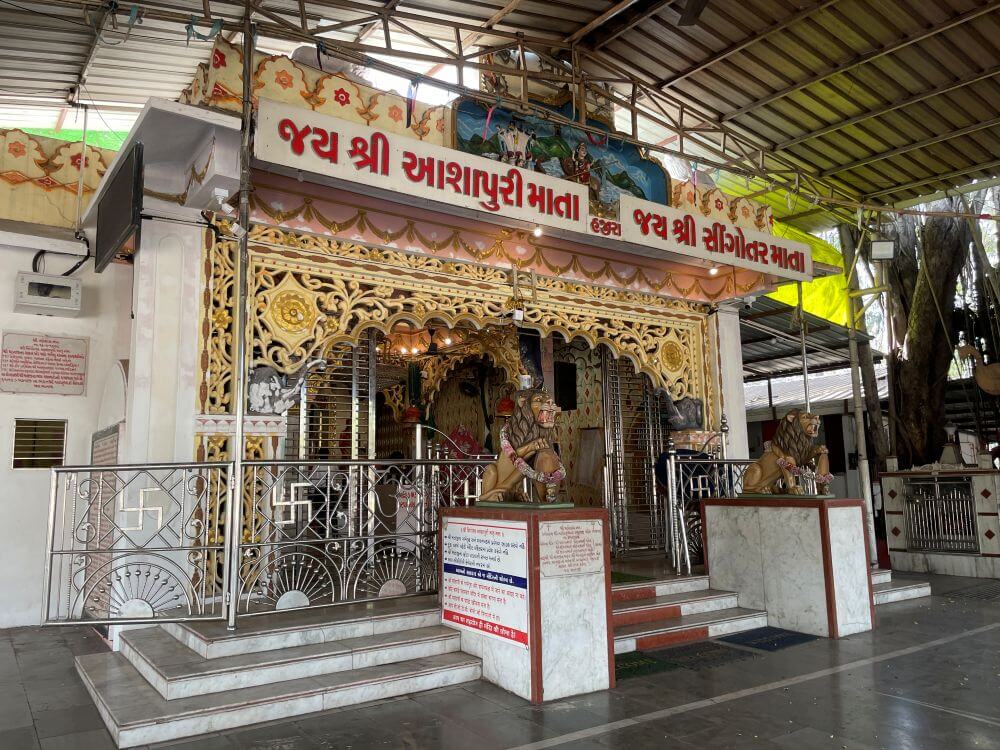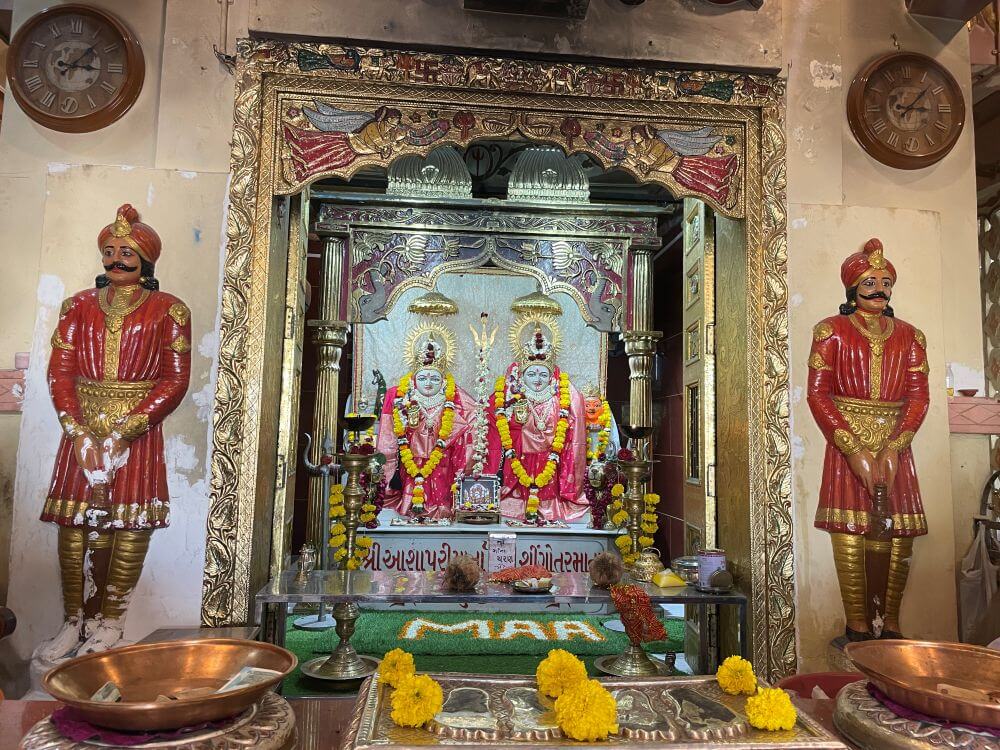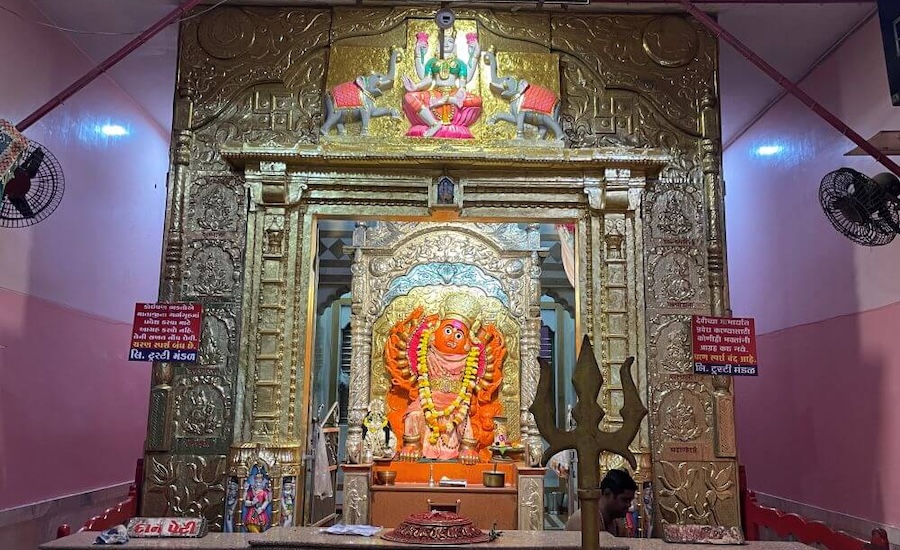
The ancient temple of Aashapuri Devi – considered the family deity (Kuldevi) of many families from Gujarat, Rajasthan, and Madhya Pradesh – and Shingotar Mata, who is worshipped as the Sea Goddess, is located in Hazira village. Aashapuri and Shingotar are considered sisters. It is believed by devotees that Aashapuri Devi resides here at the insistence of Shingotar Devi and their joint presence makes this a spiritually powerful place. Not only do the local fishermen worship here, but even high-ranking officials of major shipping companies in Surat visit the temple to seek blessings from Shingotar Mata before sending ships out to sea.
The temple is said to be at least 450 years old. According to legend, around four centuries ago, a merchant’s boat got caught in a storm at sea. The people on board began to pray to the goddess. At that moment, Aashapuri and Shingotar Devis appeared and using their tridents, brought the boat safely to shore, saving everyone. After emerging from the sea, both goddesses are said to have manifested themselves as self-emerged (Swayambhu) idols near a banyan tree close to the temple. It is also believed that the merchant requested Shingotar Mata to take residence at that location. She agreed and at her insistence, her sister Aashapuri Devi also took residence there.
Aashapuri Devi is particularly worshipped as the Kuldevi of the Panwar and Dudi community among the Jat Sikhs of Rajasthan.  She is also worshipped in the form of Shakambhari Devi. Important shrines of Aashapuri Devi are located in Sambhar (Jaipur district), Nadol (Pali district), and Mata no Madh in Kutch, Gujarat. During the time of intense conflict between the Sultan of Gujarat and Mughal Emperor Akbar near Surat, the idol of Aashapuri Devi was consecrated alongside Shingotar Mata’s idol in Hazira village in 1570 AD. The temple was renovated in 1983 and new idols were installed in 1993.
She is also worshipped in the form of Shakambhari Devi. Important shrines of Aashapuri Devi are located in Sambhar (Jaipur district), Nadol (Pali district), and Mata no Madh in Kutch, Gujarat. During the time of intense conflict between the Sultan of Gujarat and Mughal Emperor Akbar near Surat, the idol of Aashapuri Devi was consecrated alongside Shingotar Mata’s idol in Hazira village in 1570 AD. The temple was renovated in 1983 and new idols were installed in 1993.
The temple is set in a spacious courtyard in the village. There are lion statues on both sides of the temple’s entrance. Inside, to the left is the sleeping chamber (shayangriha) of the goddesses. It is said that both goddesses rest in this room every night. The room, enclosed  with glass walls, contains two separate beds prepared daily for the goddesses. A swing and other items needed by the goddesses are also present. Two tiger sculptures are there and a mural on the back wall of the chamber depicts the goddesses rescuing passengers trapped in a storm.
with glass walls, contains two separate beds prepared daily for the goddesses. A swing and other items needed by the goddesses are also present. Two tiger sculptures are there and a mural on the back wall of the chamber depicts the goddesses rescuing passengers trapped in a storm.
A banyan tree in the temple premises marks the spot where the goddesses are said to have manifested. To the left of the main temple is a shrine for Hanuman. Nearby, an old silver chariot holds the ancient idol of Shingotar Devi. A large homa kund (fire altar) and the Samadhi (memorial) of Saint Sagar Ram are also present in the complex.
On either side of the main entrance of the temple stand large lion statues atop platforms. The temple includes a  sabhamandap (assembly hall), garbhagriha (sanctum), and pradakshina path (circumambulation path). The temple features red-colored spires and subsidiary spires. Guardians (dwarpal) are carved on both sides of the sabhamandap’s entrance. Above the entrance, a carving depicts the goddesses rescuing boat passengers from a storm. The dome of the sabhamandap features intricate artwork and goddess images.
sabhamandap (assembly hall), garbhagriha (sanctum), and pradakshina path (circumambulation path). The temple features red-colored spires and subsidiary spires. Guardians (dwarpal) are carved on both sides of the sabhamandap’s entrance. Above the entrance, a carving depicts the goddesses rescuing boat passengers from a storm. The dome of the sabhamandap features intricate artwork and goddess images.
Guardians also flank both sides of the garbhagriha’s entrance. Its lintel showcases beautiful carvings with auspicious symbols, and a sculpture of Ganesha is enshrined in the central niche above. In front of the sanctum are the sacred footprints (paduka) of the goddess. Inside the sanctum, the marble idol of Aashapuri Devi is on the left, and Shingotar Devi is on the right.  The canopy above features elephants holding lotus flowers in their trunks. The adorned idols wear crowns and are shaded by golden umbrellas, with lion statues on both sides of the idols.
The canopy above features elephants holding lotus flowers in their trunks. The adorned idols wear crowns and are shaded by golden umbrellas, with lion statues on both sides of the idols.
A legend says there is a secret tunnel beneath the sanctum through which the goddesses visit the seashore every evening. Though the tunnel has since been closed, devotees claim they can still hear the sound of waves during moments of silence in the temple.
Devotees believe that sincere worship at this temple fulfills all desires and hence, hundreds of people visit regularly. Located about 25 kilometers from Surat, the coastal village  of Hazira is known for its industrial zone, home to several domestic and international companies. Fishing remains a traditional occupation for many villagers. On Narali Pournima (Coconut Full Moon), fishermen come here to offer coconuts to the goddess. People aspiring to work abroad also place their passports before the goddess and make vows. Many families also perform children’s tonsure (Mundan – first hair cutting) rituals here. Daily aartis (ritual prayers) are held in the morning and evening. Since not everyone from the village can attend the aartis in person, the locals requested the village council to install loudspeakers to broadcast the prayers. As a result, 55 loudspeakers were installed across the village.
of Hazira is known for its industrial zone, home to several domestic and international companies. Fishing remains a traditional occupation for many villagers. On Narali Pournima (Coconut Full Moon), fishermen come here to offer coconuts to the goddess. People aspiring to work abroad also place their passports before the goddess and make vows. Many families also perform children’s tonsure (Mundan – first hair cutting) rituals here. Daily aartis (ritual prayers) are held in the morning and evening. Since not everyone from the village can attend the aartis in person, the locals requested the village council to install loudspeakers to broadcast the prayers. As a result, 55 loudspeakers were installed across the village.
Various religious events are held here throughout the year. During Navratri, the festival begins with ghatasthapana (installation of a sacred pot). In February, on the temple’s foundation day, a chariot procession of the goddess is held. The procession travels through the village along the coastline and then returns to the temple. Thousands of devotees participate in this event.



